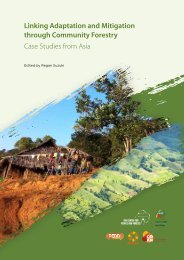Desktop Study on - Regional Climate Change Adaptation ...
Desktop Study on - Regional Climate Change Adaptation ...
Desktop Study on - Regional Climate Change Adaptation ...
You also want an ePaper? Increase the reach of your titles
YUMPU automatically turns print PDFs into web optimized ePapers that Google loves.
<str<strong>on</strong>g>Desktop</str<strong>on</strong>g> <str<strong>on</strong>g>Study</str<strong>on</strong>g><br />
In general, opti<strong>on</strong>s for reducing stresses <strong>on</strong> water<br />
resources include increasing reservoir capacity,<br />
changing the operating rules of water resources<br />
systems, promoting use of groundwater, and<br />
improving l<strong>on</strong>g- and short-range hydrologic<br />
forecasting; also changing land use practices to<br />
reduce sediment and nutrient loss to surface and<br />
groundwater could significantly enhance water<br />
quality. In particular, Malaysia has taken progressive<br />
steps towards a better watershed management<br />
by the implementati<strong>on</strong> of EIA, Envir<strong>on</strong>ment<br />
Management Plan (EMP), River Catchment<br />
Management Plan (RCMP) in major water resources<br />
and land development projects, the establishment of<br />
the Nati<strong>on</strong>al Water Resources Council in 1998, and<br />
the proposed establishment of river management<br />
authorities. The Nati<strong>on</strong>al Water Resources <str<strong>on</strong>g>Study</str<strong>on</strong>g><br />
in 1982 was the first effort of the Government<br />
to establish l<strong>on</strong>g-term plan for integrated water<br />
resources development. Since then, a number of the<br />
recommendati<strong>on</strong>s made have been taken up and<br />
followed through by the Government. It has been<br />
developed a sec<strong>on</strong>d Nati<strong>on</strong>al Water Resources <str<strong>on</strong>g>Study</str<strong>on</strong>g><br />
II (2000–50) (MOSTE, 2000)<br />
Educati<strong>on</strong> and awareness programmes to promote<br />
the idea of c<strong>on</strong>servati<strong>on</strong> and protecti<strong>on</strong> of the<br />
envir<strong>on</strong>ment and water resources am<strong>on</strong>g the<br />
general public, especially the younger populati<strong>on</strong>,<br />
are other effective l<strong>on</strong>g-term strategies to mitigate<br />
the impacts of climate change <strong>on</strong> Malaysia’s water<br />
resources (MOSTE, 2000).<br />
Am<strong>on</strong>g some n<strong>on</strong>-structural measures that<br />
have been implemented, the Urban Stormwater<br />
Management Manual (MSMA), published by DID<br />
in 2000, puts emphasis of peak discharge c<strong>on</strong>trol<br />
at source to prevent floods. In 2001, the Cabinet<br />
approved that local authorities, public and private<br />
development projects implement and compile<br />
it. It provides c<strong>on</strong>trol at-source measures and<br />
recommendati<strong>on</strong>s <strong>on</strong> flood c<strong>on</strong>trol by means of<br />
detenti<strong>on</strong> and retenti<strong>on</strong>, infiltrati<strong>on</strong> and purificati<strong>on</strong><br />
process, including erosi<strong>on</strong> and sedimentati<strong>on</strong><br />
c<strong>on</strong>trols. To achieve the objectives of the guideline,<br />
DID has reviewed previous drainage master<br />
plans, upgrade old drainage systems in stages,<br />
provided network cooperati<strong>on</strong> and support from<br />
other government, organized training courses for<br />
engineers, and imposed Erosi<strong>on</strong> and Sedimentati<strong>on</strong><br />
C<strong>on</strong>trol Plan as mandatory approval for earth works<br />
development plan (Husaini, 2007). Some practical<br />
measures implemented by the Government were i.e.<br />
the collecti<strong>on</strong> of rainfall from roof of buildings to be<br />
re-cycled for domestic use, which also will reduce<br />
the run-off and thus the frequency and magnitude of<br />
floods; later the installati<strong>on</strong> of 6-liter toilet flushing<br />
cisterns were introduced in new buildings to reduce<br />
the volume of water required per flush. Individually<br />
the amount of water saved may seem insignificant,<br />
but collectively the total amount will be c<strong>on</strong>siderable,<br />
especially in times of serious drought.<br />
Zakaira and Jamalluddin (2007) study gives three<br />
types of adaptati<strong>on</strong> measures: structural measures<br />
for inland water resources, n<strong>on</strong>-structural measures<br />
for inland water resources, and measures for coastal<br />
resources. Am<strong>on</strong>g the structural measures are<br />
listed dams, river improvements, levees, diversi<strong>on</strong>s,<br />
detenti<strong>on</strong> storage and pumping installati<strong>on</strong>s to<br />
mitigate increased flooding, and for those places<br />
where climate change reduces rainfall there is a<br />
need to upgrade our existing infrastructure for water<br />
storage. To complement structural flood measures<br />
various n<strong>on</strong>-structural measures can be taken such as<br />
flood z<strong>on</strong>ing and flood risk mapping, flood proofing<br />
and resettlement of affected populati<strong>on</strong>. Also, to<br />
sustain ec<strong>on</strong>omic growth and human well being, it<br />
is needed that the water resources plan of affected<br />
basins are reviewed to improve the effective use of<br />
water resources, the adopti<strong>on</strong> of improved water<br />
management practices in water supply, irrigati<strong>on</strong> and<br />
hydropower generati<strong>on</strong>, the development of rules<br />
and guidelines to account for climate change impacts<br />
in the nati<strong>on</strong>’s infrastructure, the employment<br />
of risk management approach in dealing water<br />
shortages due to droughts via the development of<br />
drought plans, and the sensibilizati<strong>on</strong> of the public<br />
to the problems of water wastage and to introduce<br />
policies or taxes that would cut waste and c<strong>on</strong>strain<br />
demand, i.e. through public awareness and educati<strong>on</strong><br />
programs.<br />
The current existing policy related with Water<br />
Resources Management is the Third Outline<br />
Perspective Plan (OPP3) 2001-2010 and the Ninth<br />
Malaysia Plan (9MP) 2006-2010. Malaysia climate<br />
projecti<strong>on</strong>s are required in assessing vulnerability and<br />
adaptati<strong>on</strong>; NAHRIM, the Malaysian Meteorological<br />
Department (MMD) and UKM are actively looking at<br />
climate change projecti<strong>on</strong>s in Malaysia, the RegHCM-<br />
PM (NAHRIM’s Regi<strong>on</strong>al Hydro-climate Model of<br />
Peninsular Malaysia) is the basis for the vulnerability<br />
assessment and c<strong>on</strong>sequent adaptati<strong>on</strong> measures<br />
for the 7 vulnerable sectors, and similar study has<br />
been started for East Malaysia (Sabah and Sarawak)<br />
(July 2007) (Zakaria and Jamalluddin, 2007).<br />
144

















